Discover Your Ideal Jewelry Fit with our Size Guide 0
Whether you’re discovering your ideal fit or selecting a gift for someone special,
our size guide will lead you in the right direction. Let’s find out how you measure up.
Ring Size Chart
All of our rings are crafted in standard US sizes. View the chart below to see how US sizes map to finger circumference and convert to international sizes. Engagement rings, wedding bands, and fashion rings all follow the same size format.
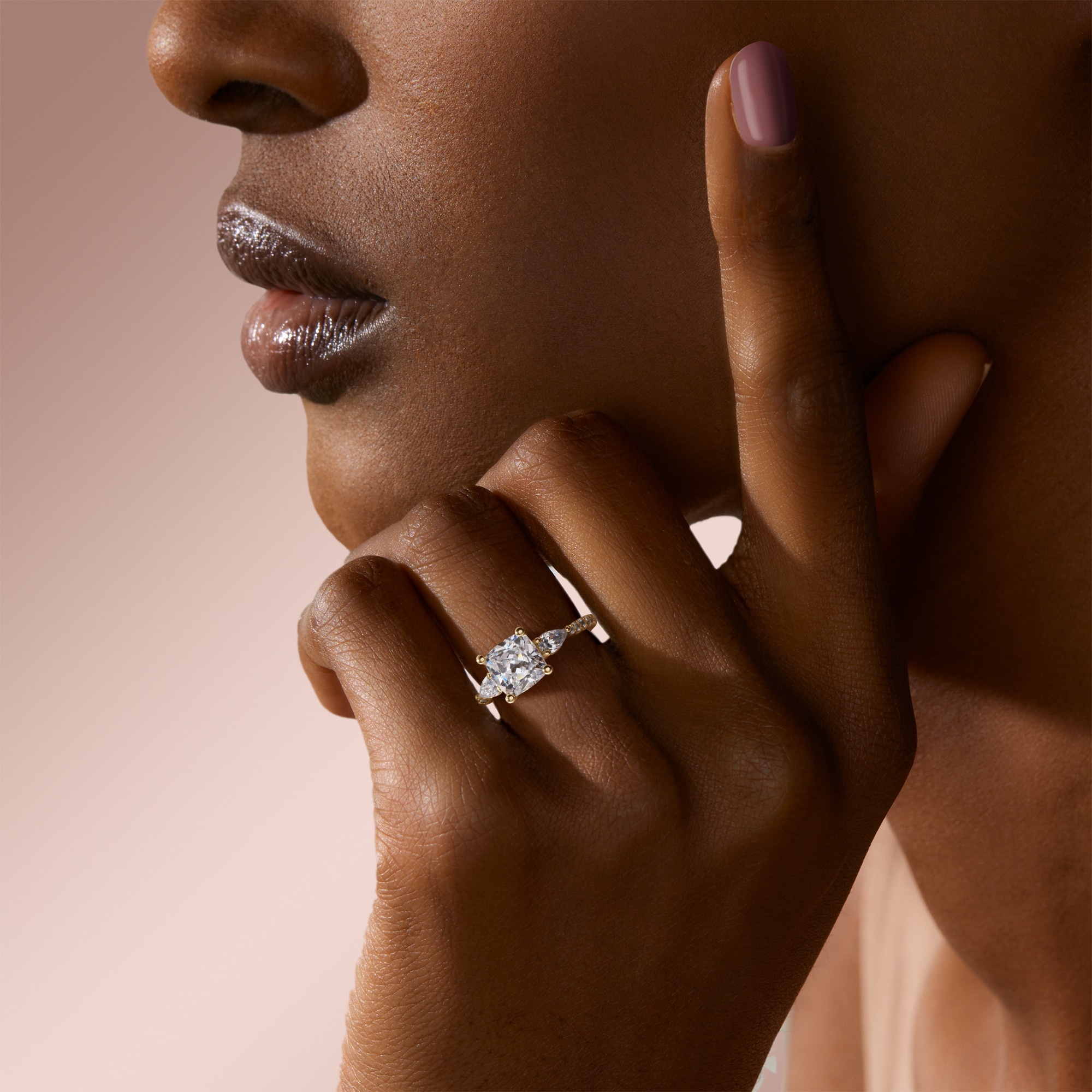
| Inside Circumference | US, Canada, Mexico | UK, Australia, Ireland, New Zealand, South Africa | France | Germany, Russia, Ukraine, Asia | India, China, Japan, South America, Turkey, Israel | Italy, Spain, Netherlands, Switzerland | |
|---|---|---|---|---|---|---|---|
| IN | MM | ||||||
| 1.74 | 44.2 | 3 | F | 44 | 14 | 4 | 4 |
| 1.77 | 44.8 | 3.25 | F 1/2 | 44.625 | 14.25 | — | 4.625 |
| 1.79 | 45.5 | 3.5 | G | 45.25 | 14.5 | 5 | 5.25 |
| 1.82 | 46.1 | 3.75 | G 1/2 | 45.875 | 14.75 | 6 | 5.875 |
| 1.84 | 46.8 | 4 | H | 46.5 | 15 | 7 | 6.5 |
| 1.87 | 47.4 | 4.25 | H 1/2 | 47.125 | 15.25 | — | 7.125 |
| 1.89 | 48 | 4.5 | I | 47.75 | 15.5 | 8 | 7.75 |
| 1.92 | 48.7 | 4.75 | J | 48.375 | — | — | 8.375 |
| 1.94 | 49.3 | 5 | J 1/2 | 49 | 15.75 | 9 | 9 |
| 1.97 | 50 | 5.25 | K | 49.625 | 16 | — | 9.625 |
| 1.99 | 50.6 | 5.5 | K 1/2 | 50.25 | 16.25 | 10 | 10.25 |
| 2.02 | 51.2 | 5.75 | L | 50.875 | — | 11 | 10.875 |
| 2.04 | 51.9 | 6 | L 1/2 | 51.5 | 16.5 | 12 | 11.5 |
| 2.07 | 52.5 | 6.25 | M | 52.125 | 16.75 | — | 12.125 |
| 2.09 | 53.1 | 6.5 | M 1/2 | 52.75 | 17 | 13 | 12.75 |
| 2.12 | 53.8 | 6.75 | N | 53.375 | — | — | 13.375 |
| 2.14 | 54.4 | 7 | N 1/2 | 54 | 17.25 | 14 | 14 |
| 2.17 | 55.1 | 7.25 | O | 54.625 | 17.5 | — | 14.625 |
| 2.19 | 55.7 | 7.5 | O 1/2 | 55.25 | 17.75 | 15 | 15.25 |
| 2.22 | 56.3 | 7.75 | P | 55.875 | — | — | 15.875 |
| 2.24 | 57 | 8 | P 1/2 | 56.5 | 18 | 16 | 16.5 |
| 2.27 | 57.6 | 8.25 | Q | 57.125 | 18.25 | — | 7.125 |
| 2.29 | 58.3 | 8.5 | Q 1/2 | 57.75 | 18.5 | 17 | 17.75 |
| 2.32 | 58.9 | 8.75 | R | 58.375 | 18.75 | — | 18.375 |
| 2.34 | 59.5 | 9 | R 1/2 | 59 | 19 | 18 | 19 |
| 2.37 | 60.2 | 9.25 | S | 59.625 | 19.25 | — | 19.625 |
| 2.39 | 60.8 | 9.5 | S 1/2 | 60.25 | 19.5 | 19 | 20.25 |
| 2.42 | 61.4 | 9.75 | T | 60.875 | 19.75 | — | 20.875 |
| 2.44 | 62.1 | 10 | T 1/2 | 61.5 | 20 | 20 | 21.25 |
| 2.47 | 62.7 | 10.25 | U | 62.125 | 20.25 | 21 | 22.125 |
| 2.49 | 63.4 | 10.5 | U 1/2 | 62.75 | 20.5 | 22 | 22.75 |
| 2.52 | 64 | 10.75 | V | 63.375 | — | — | 23.375 |
| 2.54 | 64.6 | 11 | V 1/2 | 64 | 20.75 | 23 | 24 |
| 2.57 | 65.3 | 11.25 | W | 64.625 | — | — | 24.625 |
| 2.59 | 65.9 | 11.5 | W 1/2 | 65.25 | 21 | 24 | 25.25 |
| 2.62 | 66.6 | 11.75 | X | 65.875 | — | — | 25.875 |
| 2.65 | 67.2 | 12 | X 1/2 | 66.5 | 21.25 | 25 | 26.5 |
| 2.68 | 68.1 | 12.25 | Y | 67.125 | 21.5 | — | 27.125 |
| 2.71 | 68.5 | 12.5 | Z | 67.75 | 21.75 | 26 | 27.75 |
| 2.72 | 69.1 | 12.75 | Z 1/2 | 68.375 | — | — | 28.375 |
| 2.75 | 69.7 | 13 | — | 69 | 22 | 27 | 29 |
How to Measure Ring Size at Home
The three easiest ways to measure your ring size without our free sizer are:
- The string method
- Using a printable ring sizer
- Measuring an existing ring to determine a size that already fits
These methods require our Ring Sizer & Conversion Chart. To print the chart for methods two or three, set page scaling to “100” in your print settings and use 8.5 x 11-inch standard paper.
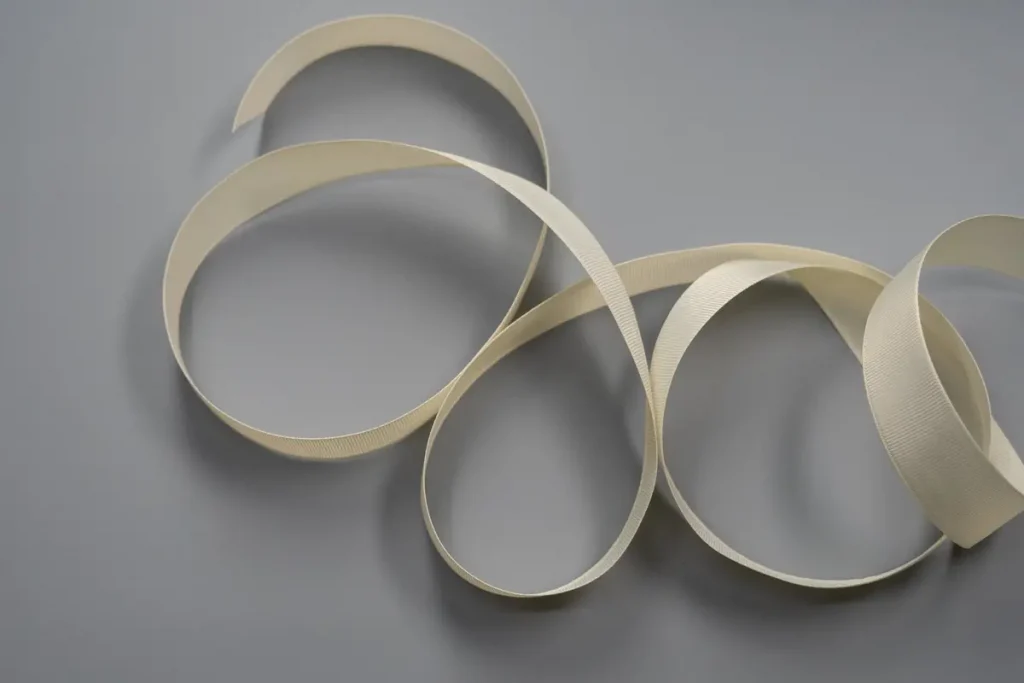
Method One:
Create Your Own Ring Sizer
What you’ll need:
- Printer & paper
- String, yarn, floss, or a thin strip of paper
- Pen or marker
- Ruler
Steps:
1. Cut a piece of string, yarn, floss, or thin strip of paper to at least three inches long.
2. Wrap one end of the string around the base of the intended finger.
3. Using a pen or marker, mark where the end of the string overlaps with the rest.
4. Lay the string flat and use a ruler to measure the length between the end and your mark in millimeters.
5. Use the Ring Size Conversion Chart to match the millimeter length to the corresponding ring size.
Method Two:
Print a Ring Sizer
What you’ll need:
- Printer & paper
- Scissors
Steps:
1. Print the Printable Ring Sizer & Conversion Chart. Set page scaling to “100” in your print settings and use 8.5 x 11-inch standard paper.
2. Cut out the ring sizer and the slot as instructed.
3. Wrap the paper ring sizer snuggly around the base of the intended finger so that the numbers are visible and insert the pointed end through the slit you made in the sizer.
4. Note the number that lines up with the slit; this is your ring size! Remember that quarter sizes are also available if your sizer indicates that you are between whole and half sizes.
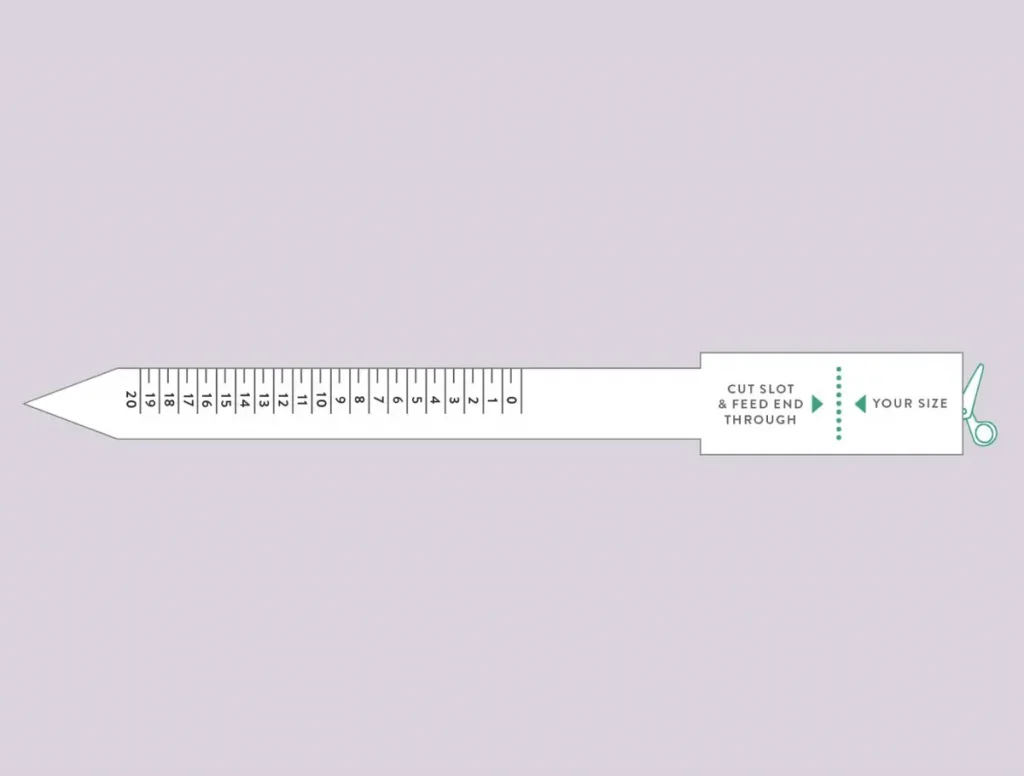
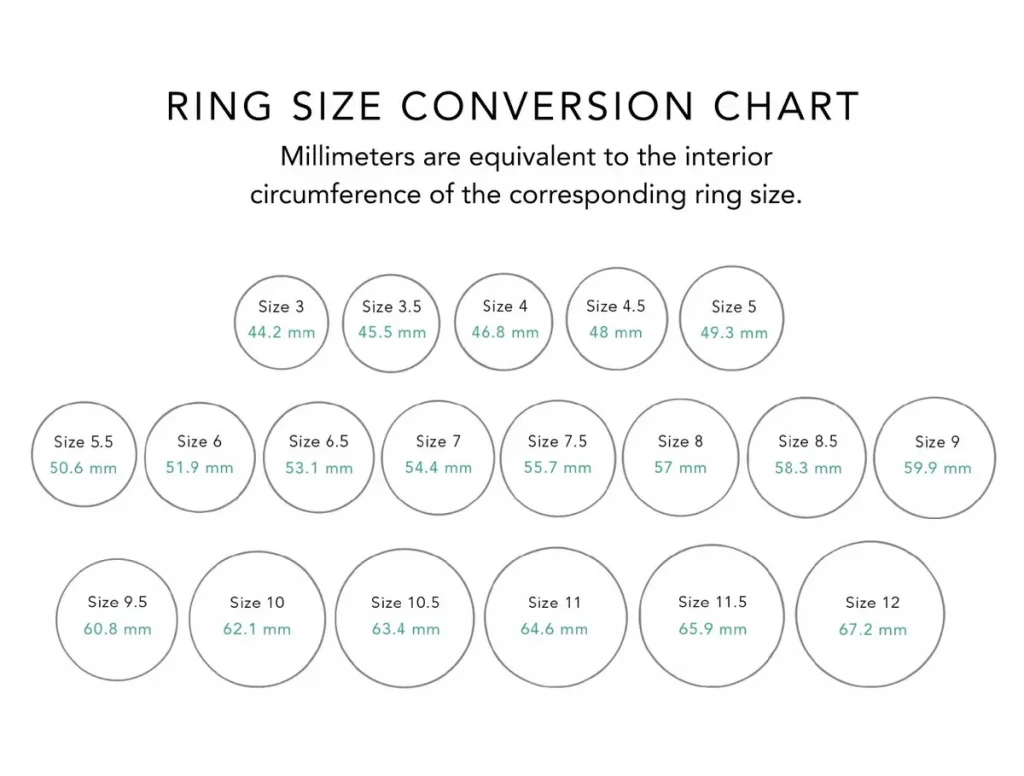
Method Three: Measure an Existing Ring with Our Chart
What you’ll need:
- Printer & paper
- Scissors
- An existing ring
Steps:
1. Print the Printable Ring Sizer & Conversion Chart. Set page scaling to “100” in your print settings and use 8.5 x 11-inch standard paper.
2. Choose a ring that correctly fits the intended finger.
3. Lay the ring over each size circle within the chart until you can closely match the inside edge to one of the circles on the guide. If the ring falls between two sizes, contact us to order the quarter size between them.
How Should a Ring Fit?
A ring that fits appropriately will slide over your knuckle with minimal friction and sit snugly on your finger without feeling too tight. You should feel slight resistance but not need to apply too much force to take it on and off.
What to Do If You’re in Between Ring Sizes
If you’re in between ring sizes, we suggest sizing up rather than sizing down. Finger size can fluctuate throughout the day, and a ring that is too tight may not come over the knuckle easily — which can be painful. Additionally, there are simple, at-home ways to make a slightly loose ring feel tighter, but you’ll need to consult a professional to size it up. Remember, if a half size doesn’t feel quite right, contact us and we can craft a design in a quarter size to help you find the perfect fit.
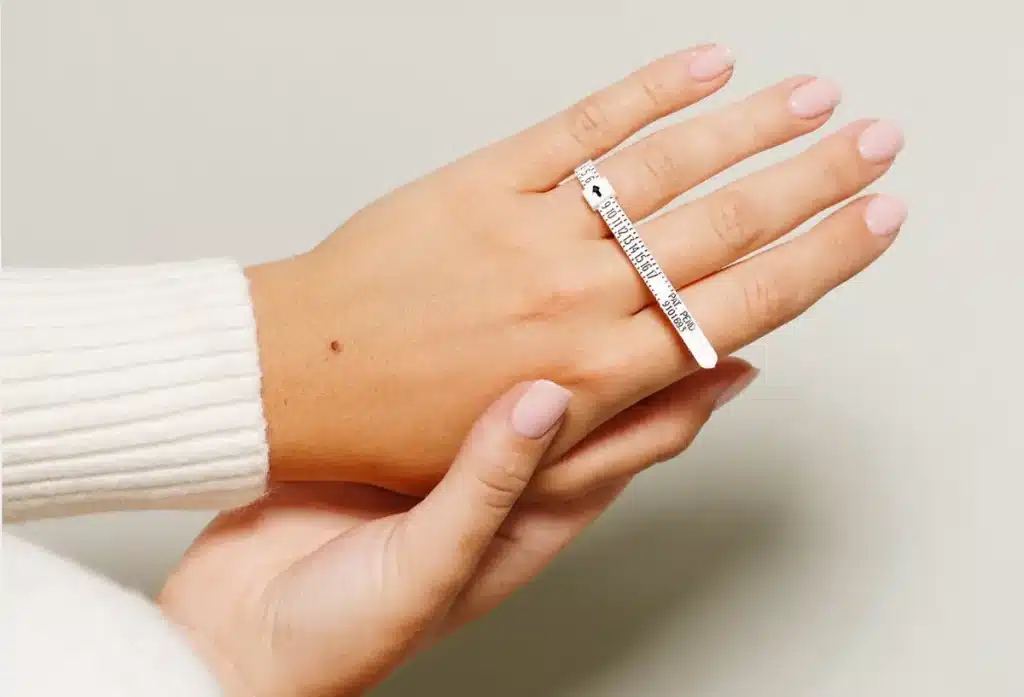
Ring Size Tips
- Our dominant hands are generally slightly larger – measure the hand you plan to wear the ring on.
- Consider the design of your ring. Rings with wider bands will fit tighter. Plan to size up by at least a half size for chunky bands (>4mm) and size down accordingly for very thin designs (<1.3mm). Note that ring sizes are generally measured in millimeters (mm) and are not sized by inch.
- Ensure your body temperature is normal – fingers tend to shrink when cold and expand when hot.
- Fingers change size throughout the day based on the water we drink and the food we eat – the best time to measure is towards the middle or end of the day.
- If your knuckle is pronounced, you may want to measure both the knuckle and the base of the finger. Then, choose a size in between those measurements as rings need to fit over the knuckle but not be too loose or tight to wear comfortably.
Ring Size FAQs
Does Candia Cameo offer half-ring sizes?
Yes! You can always order half-size rings to ensure you find the perfect fit. You can also request a design in a quarter size by contacting us via Whatsapp 00971585782060 or email .
What if I order the wrong ring size?
If you order the wrong size, contact us to begin the complimentary resize process within 60 days of when your piece was initially shipped out to you. We’ll confirm a new size with you and resize your ring free of charge. If you ordered an eternity ring, open band, alternative metal design, or any other style that cannot be resized, you may exchange it for the correct size within our 30-day policy and exchange does not apply to bespoke pieces. To learn more about these policies and their constraints, consult our Free 30-Day Returns & 60-Day Resizes page.
What is the average ring size for women?
The average ring size for women is between size 5 and 7, though this can vary greatly.
What is the average ring size for men?
The average ring size for men is between 8 and 10. Use our printable chart or order a free ring sizer to determine the perfect size.
How do you secretly get a ring size?
If you need to know your partner’s ring size without them knowing, selecting a standard size or slightly larger size is the best choice. The average size for women’s rings is 6, and for men’s rings 9. You can also try measuring a ring they already wear or asking a friend or family member if they know their size. Whichever method you go with, always double-check the product detail page to confirm that your specific design can be resized to ensure you can eventually find the perfect fit. For more tips, read our in-depth guide on How to Measure Ring Size for a Surprise Proposal.
Are you shopping for beautiful handmade bracelets?
Wondering how to find your bracelet size, what size would suit you the best and how to style your bracelets? Allow us to guide you to your perfect match. In this guide, we tell you all you need to know about bracelet and wrist size, styles, and how to measure your wrist to get the right bracelet fit.
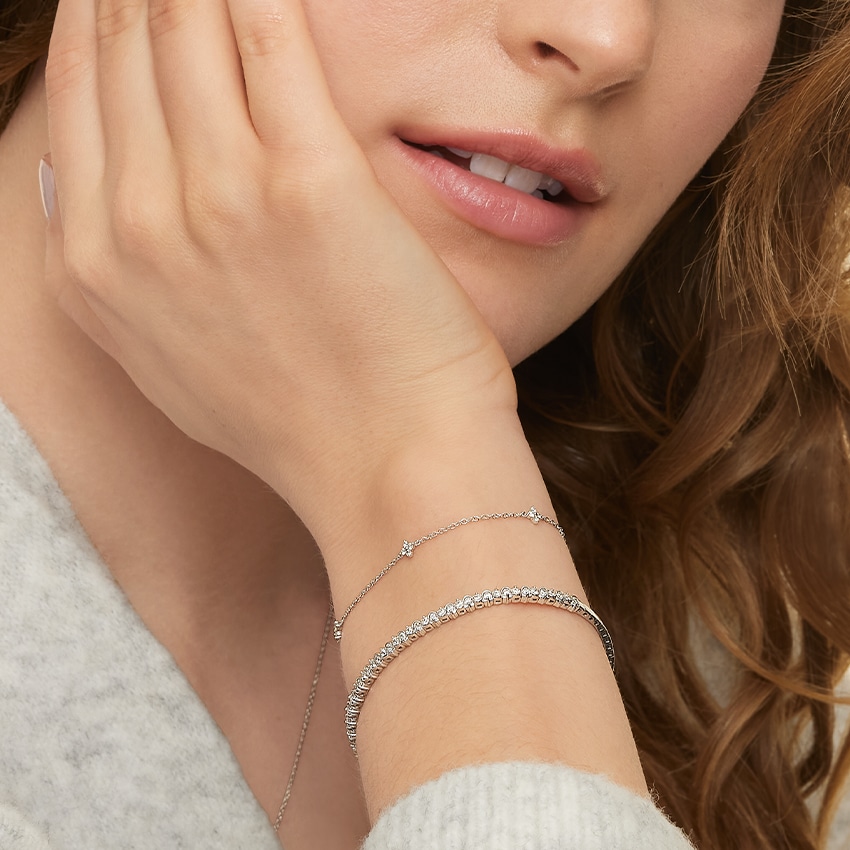
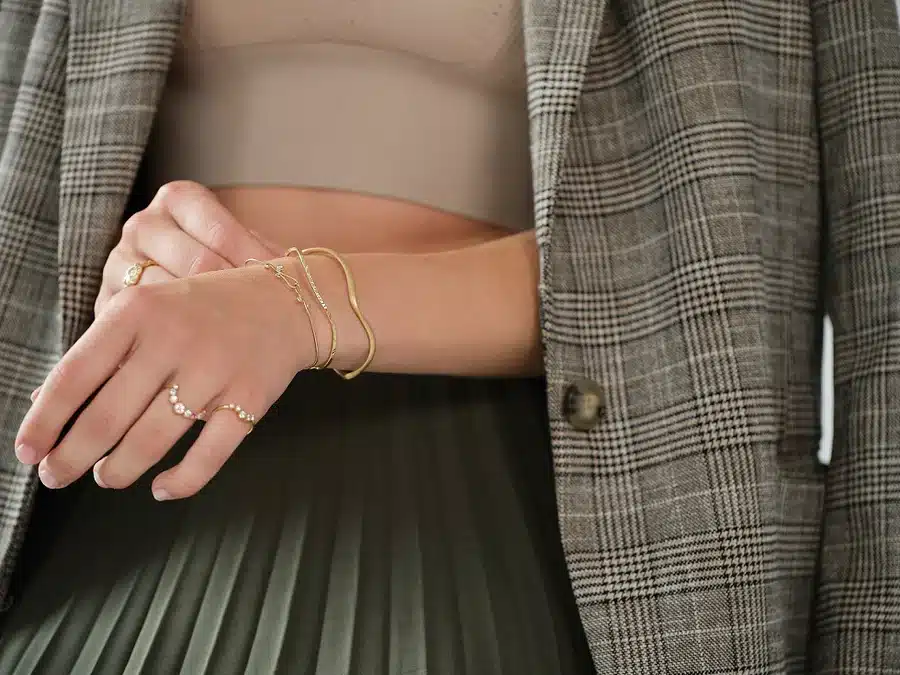
Finding the correct bracelet size is important
A bracelet is a flexible jewellery made for wrists, crafted in materials like cords, nylon threads or metal chain links. Like necklaces, bracelet designs have flowing lines that capture movement and sound as well as the play of light on lustrous metals and gemstones. As almost all bracelets open and close with size-adjustable clasps, bracelet sizes need not be exact. But for a good fit, it’s necessary to make appropriate measurements to find your best bracelet sizes.
Bangles and bracelets are worn on the forearm, anywhere between the widest point of the arm and the wrist bone. Just like the correct bangle size matters, it is good to find the right size for a perfect bracelet fit because how appealing it will look on you depends on a good fit.
Measure yourself for bracelet sizing
To find your bracelet size, you can measure your wrist size or a favourite bracelet that you already have!
You will need…
A flexible tape measurer / a paper strip / a piece of ribbon / string and a straight ruler
or
A bracelet that fits you well
1. Measure your wrist size
Step 1: Wrap the tape measure around the wrist bone, so that it fits snugly without feeling too tight or too loose.
Step 2: Mark where the tape measure overlaps. This is the exact circumference of your wrist.
Note: You can substitute the measuring tape with a string or ribbon and use a straight ruler to measure the length from the point of overlap to the end.
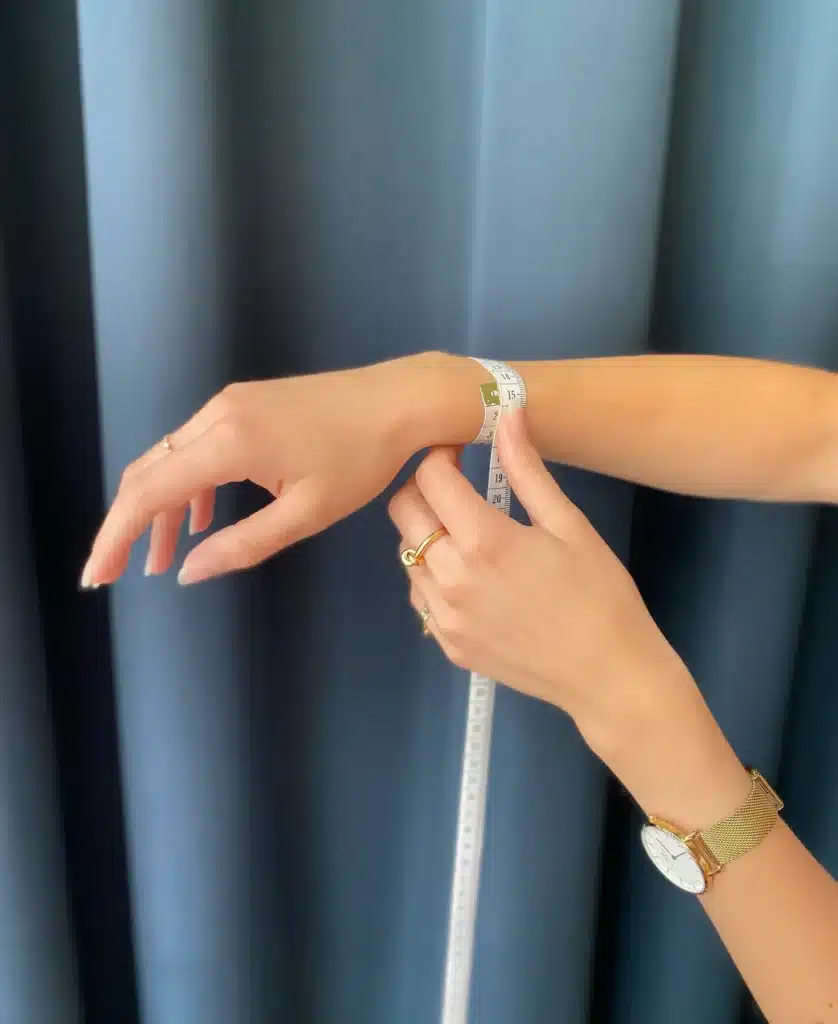

2. Measure the length of a bracelet that fits well
If you already have a chain bracelet that fits right, this is how to substitute wrist tape measurements with the bracelet chain length:
Step 1: Open your bracelet and place it on the table
Step 2: Using the centimetre/inch edge of a ruler, measure the length of the bracelet cord/chain from the outer edge of the clasp to the other end of the bracelet.
Note: The flexible tape measurements are the circumference of your bracelet. To convert circumference to diameter, you can divide the millimeter (mm) Circumference measure by 3.14 (D = C/3.14) or use an online converter
Understanding bracelet size charts
We know that bangle size has to be precise because the design is rigid. But most bracelets are manufactured to allow a comfortable fit for most wrist sizes. This is because, unlike bangles, bracelets have clasps that allow the wearer to adjust the size. Here’s some information that will help you buy bracelets as gifts for friends and family.
Industry Standard Sizes
For women, the industry-standard bracelet diameter is 7 inches/17.7cm; for men, the standard is 8 inches/20.32cm.
Standard Bracelet Size Chart Measurements
Note: This chart is not standard for all brands but is only a reference to help you understand sizing
| Wrist Measurement (CM) | Wrist Measurement (INCHES ”) | Suitable for |
| 14-15 cm | 5.5-5.9” | Teens, slim/petite girls/women |
| 15-16.5 cm | 5.9-6.5” | Suitable for slim women |
| 16.5-17.5 cm | 6.5-6.9” | Standard female size for most women, slender men, and teens |
| 17.5-18.5 cm | 6.9-7.3” | Standard male size, suitable for some women |
| 18.9-19.5+ cm | 7.3-7.7+ in | Men and women |
Find your bracelet size and fit for the best look
In general, we can divide bracelet fits into snug, comfortable and loose. The general rule of thumb to get your best fit is to add the following to your measured wrist size and then choose the next size from the brand’s size chart.
-If you like to wear your bracelet snug around your wrist, you like it quite tight. Choose the size closest to your wrist measure from the size chart. This is the right size for leather or cord bracelets that are styled to be worn snugly.
-If you want a comfortable fit with enough room to pass a little finger all around, then you should go for the next bigger size range on the size chart. Best for charm, gemstone or chain bracelets.
Bracelet sizes and your perfect size
Bracelet size charts show the total bracelet circumference lengths measured in either centimetres or inches (1″ = 2.5 cm). The first thing to consider is the fit or the tightness of the bracelet. Give some thought to the snugness or looseness you desire. There are two easy ways to measure your wrist to find your bracelet size (total circumference).
| FIT | Your wrist measurement (CM) | Your wrist measurement (INCHES”) |
| Snug Fit | + 0.5 – 1cm | + 0.25 – 0.5″ |
| Comfort Fit | + 2 – 2.5cm | + 0.75 – 1″ |
| Loose Fit | + 3cm | + 1.25″ |
Standard Shamballa Bracelet size chart for men and women
All Shamballa bracelets differ slightly from other bracelets, as they are macrame-cord braided with different styles of beads, colour cords, gold and gemstones. When choosing a Shamballa bracelet, match your snug-fit wrist measurement against the Shamballa bracelets size chart here.
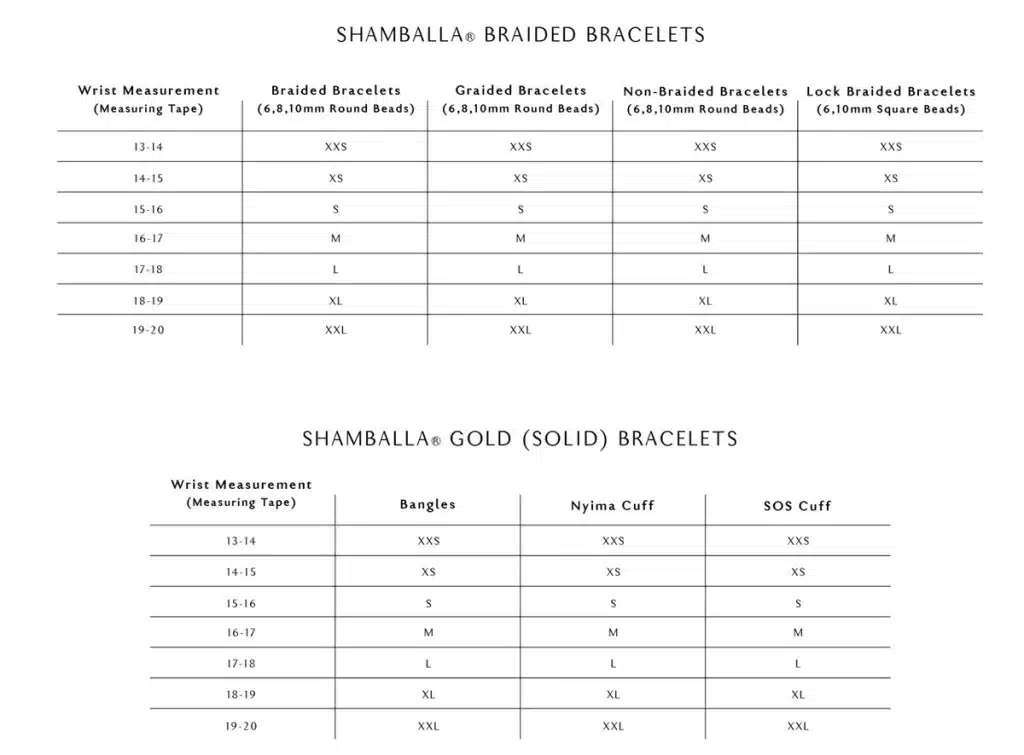
The perfect bracelet size for different styles and looks
Remember the rule for styling accessories is that there are no rules! The first thing is to have fun and wear who you are. You have our permission to enjoy your daily bracelet with as many wrist companions as you fancy! Based on the vast collection of designer bracelets we carry here at The Jewellery Room, we have put together 3 bracelet styles and bracelet sizing tips for each.
The classic chain bracelets:
This bracelet type is usually in gold, sterling silver, or rhodium or gold plated chains that have a lobster or a T-bar/toggle clasp and are therefore adjustable by a few centimetres. If your wrist size falls in the small range, go for the closest match in the lower range. On the other hand, medium to large wrists should wear the upper limit size.
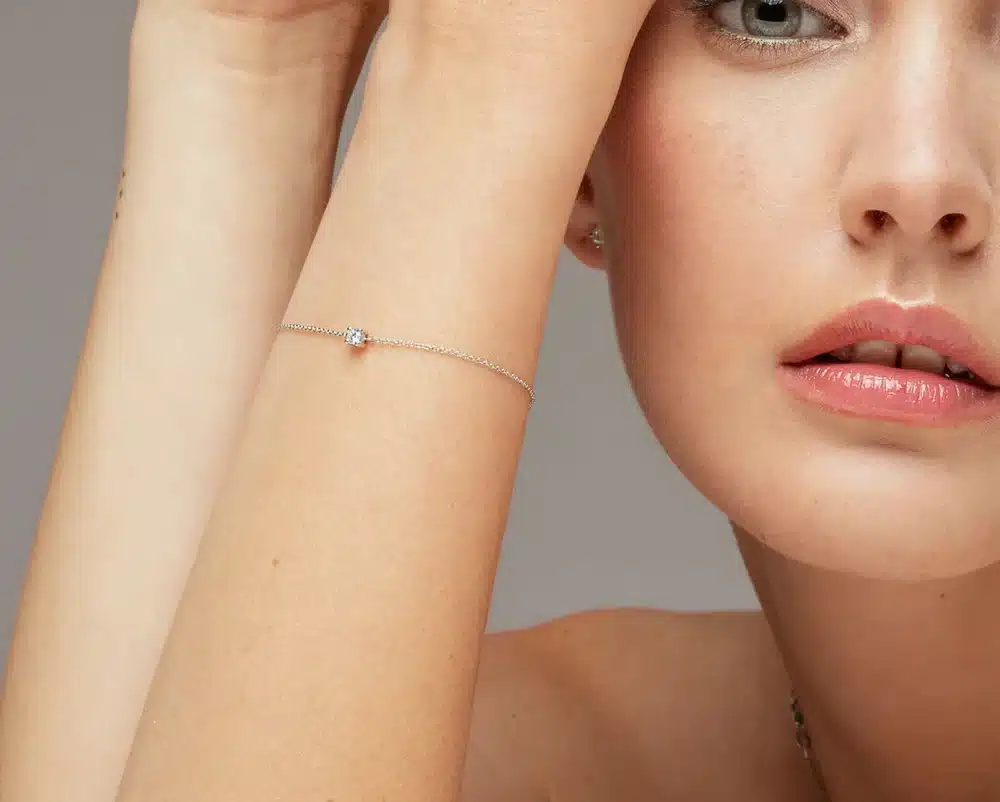
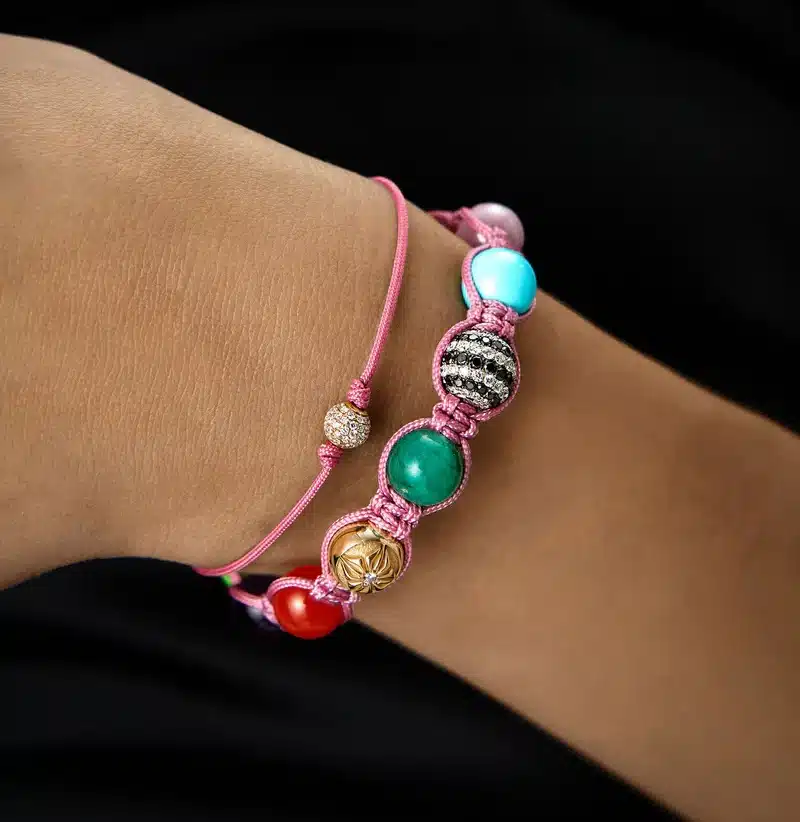
Gemstone and charm bracelets are also step-up versions of plain chain bracelets and are therefore adjustable. Some of our adjustable cord bracelets also come with lovely charms and precious gemstones. Choose the upper-size range closest to your wrist’s snug-fit size.
Tennis bracelets: Diamond-studded tennis bracelets are everyone’s favourite and here at The Jewellery Room, we have a fine selection of classy tennis bracelets from exceptional designers who work with high-quality materials to create a lasting piece of fine jewellery. Choose the upper-size range closest to your wrist’s snug-fit size.

What Are The Different Necklace Sizes?
Necklaces range in size from trendy choker-like styles that measure at 14 inches, traditional, elegant pendants that rest at the average 18 inches, while many strand styles and men’s necklaces reach 30 inches and beyond.
Necklaces generally range in length from 14 inches to 36 inches. Choosing the right necklace size depends solely on personal style: do you prefer something that rests just above the collarbone? Or something that rests further down the chest? Or you may decide to wear multiple different chain lengths at once to create a chic stack.
As a note, we haven’t broken this up by gender. We recognize that the size, shape, and needs of a person’s body and style vary greatly across the population and we aim to give the most informative information possible based on where necklaces rest on the human form. Let’s dig into the different sizes and where they’ll rest on your chest!
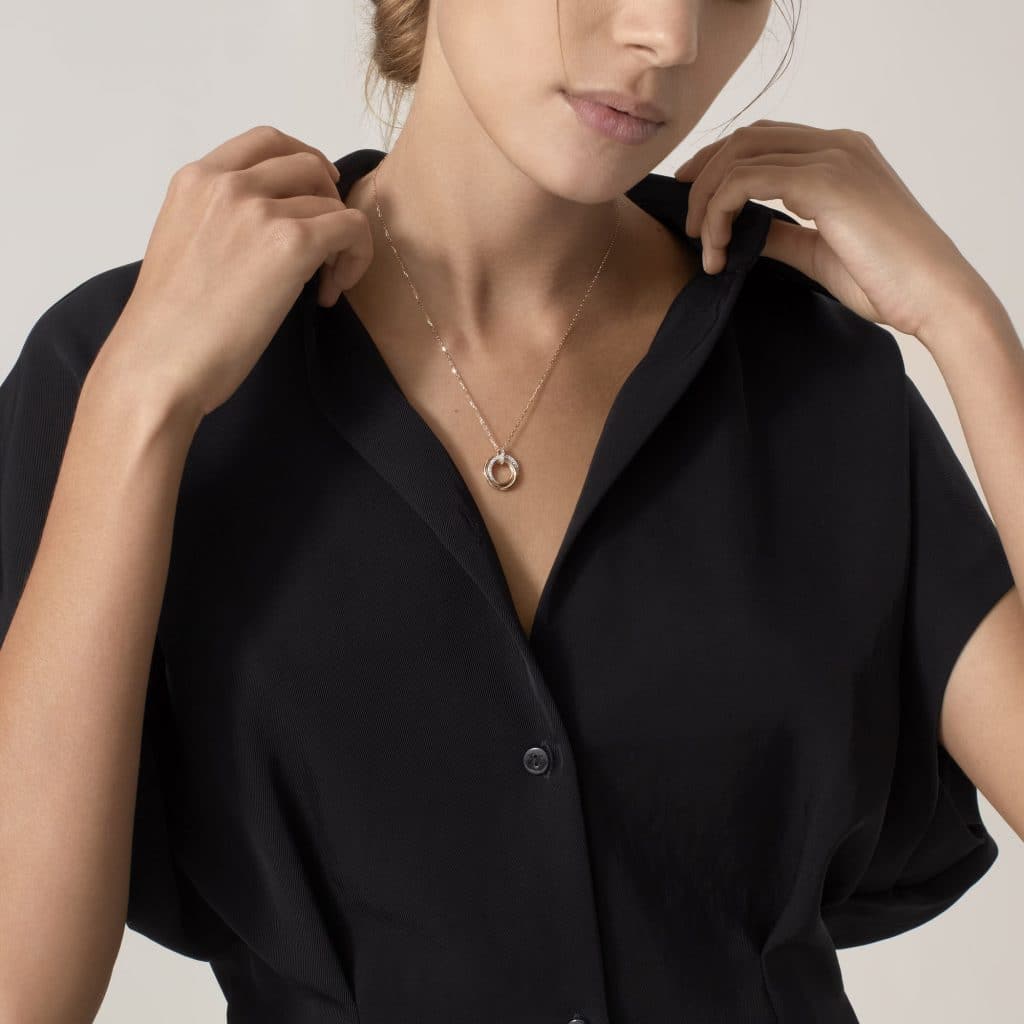
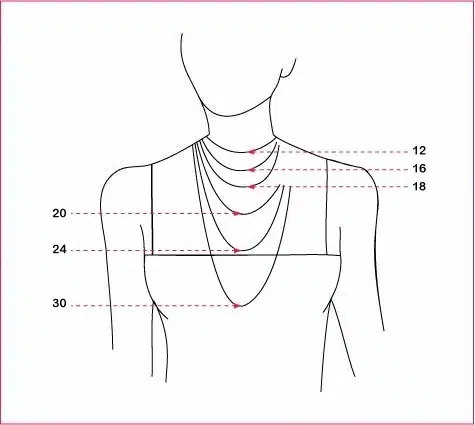
What Are The Standard Necklace Lengths?
Necklaces come in standard sizes of 14”, 16”, 18”, 20”, 22”, 24”, 30” and 36”. Though all necklaces are standardized in size, each length will rest differently on different body types.
14 Inch Necklaces
Generally the shorter length of necklaces for women on offer, 14 inch chains rest around the neck like a choker, making this length a trendy choice for those ready to make a statement. 14 inch necklaces also pair incredibly well with other chain lengths as they won’t get tangled at the base of your neck.
16 Inch Necklaces
These necklace lengths rest just above the collarbone and are the shortest necklaces not considered chokers. They also pair well with others and are not quite as bold as chokers –they’re trendy but still chic.
18 Inch Necklaces
This length is what’s considered the average necklace length. It’s certainly the most common and rests just below the clavicle – you’ll often see this length worn with a traditional pendant for a sweetheart look.
20 Inch Necklaces
More often than not, this is the shortest length on offer for men’s chains. For both men and women, this length falls an inch or two below the collarbone and can easily be worn beneath higher-cut shirts and sweaters.
22 Inch Necklaces
These necklaces rest about halfway between the clavicle and the sternum. For women, this length is often worn with a pendant over the clothes in a trend-forward outfit. For men, this length is often chosen for statement chains that can be worn on top of or underneath clothes.
24 Inch Necklaces
Reaching towards the top of the ribs, 24 inch necklaces are one of the longest necklaces you’ll see worn by both men and women that aren’t doubled over. They stack excellently with other chains for a glammed-up look. They’re also the most popular necklace length for both men and women in religious and sentimental items.
30 Inch Necklaces
Most often, these necklaces are doubled over. If worn as-is, they almost reach the stomach. The long length provides flexibility – in doubling it over you can have two necklaces of the same size or split the lengths so one strand is choker-length while the other dangles below.
36 Inch Necklaces
Also a popular necklace size to be worn doubled over, 36 inch necklaces are generally the longest on offer. These can reach past the belly button on both men and women.
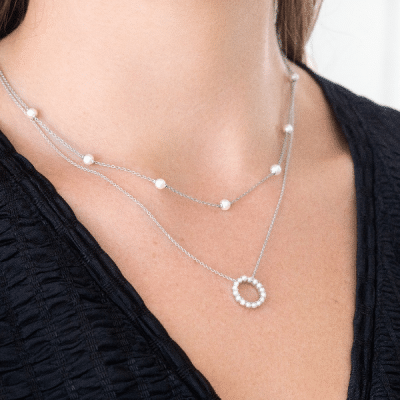
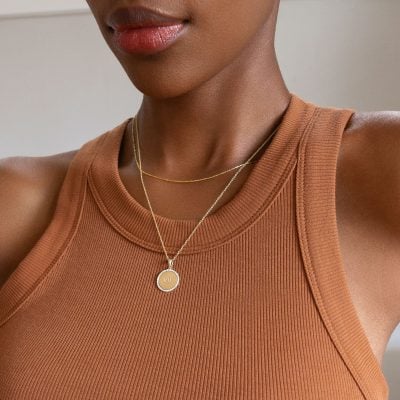
Factors To Consider When Selecting Necklace Lengths
Height
Most average-height or taller people can wear any length necklace. If you’re taller than average, a shorter necklace may not be best to balance out your look. The opposite is also true: if you’re petite height-wise, an extra-long chain may fall even lower on you than on the average person.
Neck Size
Some people’s necks are narrower than others – in this case, a short chain will fall a little lower than the average. For example, a 16 inch chain may appear to fall at the 17 or 18 inch range if the neck in question is thin.
For people with thicker necks, a longer chain length will have the opposite affect: it’ll make the necklace look shorter. If your neck is thick, we recommend choosing the next longest length so that you can achieve the style you’re looking for and also be comfortable!
Outfit and Styling
Different necklace lengths work best with different outfits. For example, a super plunging blouse may want to wear a longer chain to fill the space. Long chains also look fabulous on top of more flowy blouses and many people choose to also add a large pendant for extra oomph.
These days, stacks are all the rage: no matter what kind of shirt or neckline: stack, stack, stack. The most popular stack combination is wearing 16, 18, and 20 inch necklaces all together so that the pendants and chains rest closely together without touching.
Other people choose to not only mix lengths but also mix metal. Wear a 16 inch silver necklace with a heavy 20 inch gold one for a bold, adventurous look.
You can also mix and match different chain widths. A 14 inch dainty, minimalist pendant pairs excellently with a thick, 16 inch statement necklace.
How Do I Know My Necklace Size?
There are two ways to measure the length of a necklace.
If you already have a necklace whose length you love, you can use its measurements to decide the length of your next purchase. You can take the measurements of your existing necklace using either a string or a tape measure by laying it down and straight on a flat surface and taking the measurements.
The second way is to take a flexible tape measure and put it around your neck as if you were wearing a necklace. Then adjust it to the desired length then note down the measurement.
Alternatively, you can use a string to take measurements in the absence of a tape measure. put a marker on the string at the point you want your necklace to reach. You can then measure it later against a tape measure or a ruler then note it down.
What’s A Good Necklace Length For Women?
Women’s necklaces usually range between 16 inches and 20 inches, with the most popular length measuring at 18 inches. The way the necklace rests will be determined by the unique shape of a women’s body – so we recommend taking in factors like neck size and torso length.
In Conclusion
The best necklace lengths will depend on the day, your styling choices, and the size of your body. Luckily enough, the sizes are standardized across the jewelry industry and apply to both men and women – there’s no convoluted and confusing metrics, you just need to figure out what works best for you. We recommend using the above measurement tactics to determine what looks best or visiting a jeweler and trying on different lengths. To each their own!